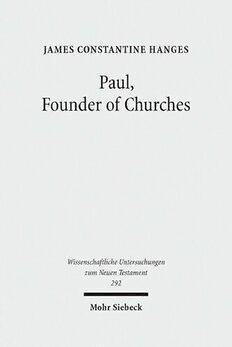
Paul, Founder of Churches: A Study in Light of the Evidence for the Role of "Founder-Figures" in the Hellinistic-Roman Period PDF
575 Pages·2012·4.795 MB·English
Most books are stored in the elastic cloud where traffic is expensive. For this reason, we have a limit on daily download.
Preview Paul, Founder of Churches: A Study in Light of the Evidence for the Role of "Founder-Figures" in the Hellinistic-Roman Period
Description:
The apostle Paul's understanding of his role and responsibilities in transferring the cult of Jesus Christ to new lands to found new groups devoted to this immigrant son of God is not unique. His modus operandi cannot be adequately explained in terms of Jewish precedents. Rather, Paul's pattern is a creative appropriation of the enduring Greek model of the founder, the key figure in Greek imaginings of the formation of social space, whether colony or cult. Cult foundation inscriptions as well as literary descriptions show that such foundations were laid according to persistent elements of a pattern originating in Greek foundation narratives focused on the oracular selection of the founder-figure and his obedience to a divine impetus for cult innovation. With the help of modern culture studies, especially postcolonial critique, Paul's letters show that he not only appropriated this traditional Greek model and applied it to the foundation of his churches, but creatively adapted it for purposes of group self-definition and his own sensibilities. While Paul uses few technical foundation terms, his reliance on divine visionary endorsement of his transfer of the Christ cult to new places, the way the apostle exercises authority over the communities he has founded, his attempt to integrate his Greek communities into the sacred history of Israel, and the strategies used against him by his opponents reveal his use of the Greek foundational model. Paul shares the discourse and action of contemporary cult founders who, like him, were obeying their deity's call for transferal to a new location.
See more
The list of books you might like
Most books are stored in the elastic cloud where traffic is expensive. For this reason, we have a limit on daily download.
